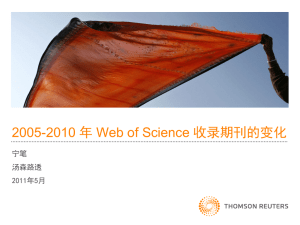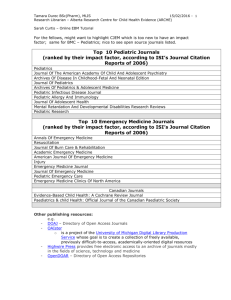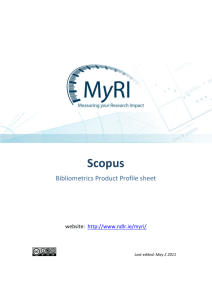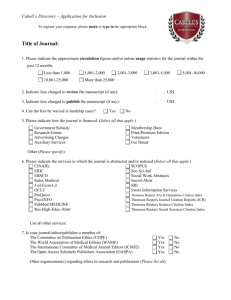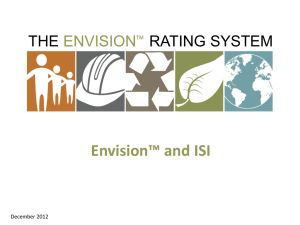Message from the Unit Welcome greeting from the
advertisement
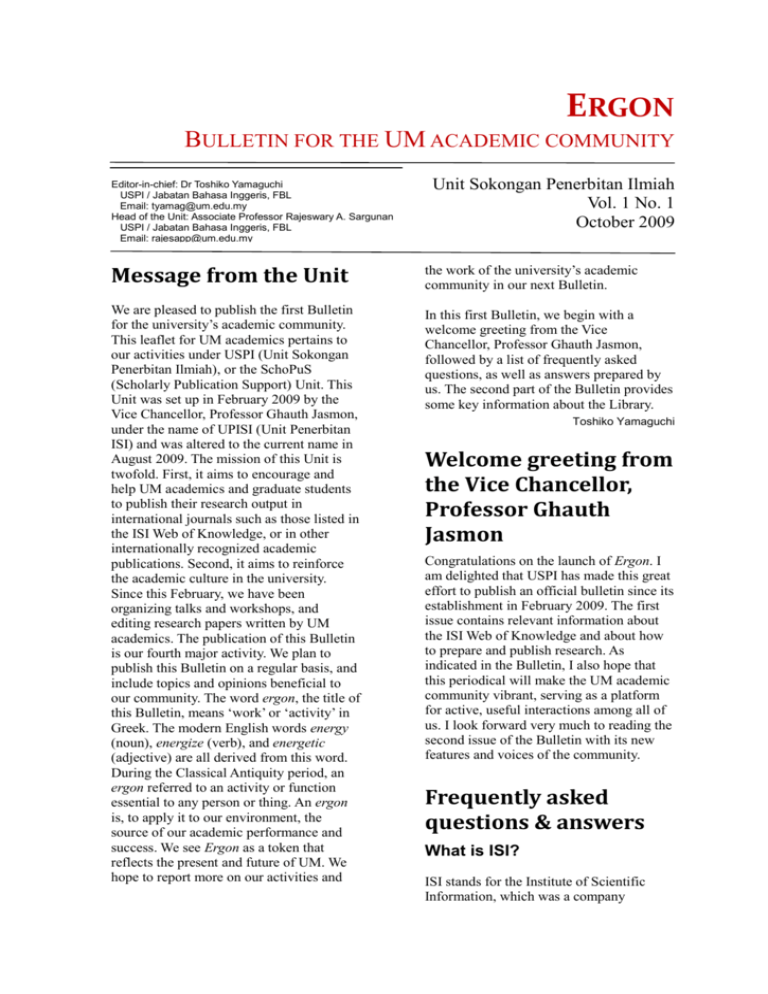
ERGON BULLETIN FOR THE UM ACADEMIC COMMUNITY Editor-in-chief: Dr Toshiko Yamaguchi USPI / Jabatan Bahasa Inggeris, FBL Email: tyamag@um.edu.my Head of the Unit: Associate Professor Rajeswary A. Sargunan USPI / Jabatan Bahasa Inggeris, FBL Email: rajesapp@um.edu.my Unit Sokongan Penerbitan Ilmiah Vol. 1 No. 1 October 2009 -Message Dr.Rajeswary A.from Sargunanthe Unit the work of the university’s academic community in our next Bulletin. We are pleased to publish the first Bulletin for the university’s academic community. This leaflet for UM academics pertains to our activities under USPI (Unit Sokongan Penerbitan Ilmiah), or the SchoPuS (Scholarly Publication Support) Unit. This Unit was set up in February 2009 by the Vice Chancellor, Professor Ghauth Jasmon, under the name of UPISI (Unit Penerbitan ISI) and was altered to the current name in August 2009. The mission of this Unit is twofold. First, it aims to encourage and help UM academics and graduate students to publish their research output in international journals such as those listed in the ISI Web of Knowledge, or in other internationally recognized academic publications. Second, it aims to reinforce the academic culture in the university. Since this February, we have been organizing talks and workshops, and editing research papers written by UM academics. The publication of this Bulletin is our fourth major activity. We plan to publish this Bulletin on a regular basis, and include topics and opinions beneficial to our community. The word ergon, the title of this Bulletin, means ‘work’ or ‘activity’ in Greek. The modern English words energy (noun), energize (verb), and energetic (adjective) are all derived from this word. During the Classical Antiquity period, an ergon referred to an activity or function essential to any person or thing. An ergon is, to apply it to our environment, the source of our academic performance and success. We see Ergon as a token that reflects the present and future of UM. We hope to report more on our activities and In this first Bulletin, we begin with a welcome greeting from the Vice Chancellor, Professor Ghauth Jasmon, followed by a list of frequently asked questions, as well as answers prepared by us. The second part of the Bulletin provides some key information about the Library. Toshiko Yamaguchi Welcome greeting from the Vice Chancellor, Professor Ghauth Jasmon Congratulations on the launch of Ergon. I am delighted that USPI has made this great effort to publish an official bulletin since its establishment in February 2009. The first issue contains relevant information about the ISI Web of Knowledge and about how to prepare and publish research. As indicated in the Bulletin, I also hope that this periodical will make the UM academic community vibrant, serving as a platform for active, useful interactions among all of us. I look forward very much to reading the second issue of the Bulletin with its new features and voices of the community. Frequently asked questions & answers What is ISI? ISI stands for the Institute of Scientific Information, which was a company October 2009 founded by Eugene Garfield (an American scientist with a PhD in structural linguistics) in 1960. ISI started compiling bibliographical databases and was a pioneer in the indexing of academic journal citations. In 1992, ISI was acquired by another company, the Thomson Corporation, and the merger gave rise to Thomson ISI. Since 1992, the company has grown rapidly and the Thomson Corporation merged Thomson ISI with its other scientific content providers, such as Derwent, to create a new business known as Thomson Scientific (there were other businesses under the Thomson Corporation such as Thomson Financial, Thomson Legal, Thomson Healthcare, and Thomson Learning). Then, in April 2008, the Thomson Corporation acquired Reuters, and the entire enterprise is now called Thomson Reuters. The ISI business is now under the Healthcare and Science business of Thomson Reuters, and the citation database remains one of its flagship products. Since the initial plan of ISI was to index scientific citations, the first citation index that was produced by ISI was the Science Citation Index (SCI) (1964) Building on the SCI model, two other citation databases were produced, namely the Social Sciences Citation Index (SSCI) in 1973 and the Arts and Humanities Citation Index (AHCI) in 1978. It has often been claimed that the importance of Eugene Garfield’s bibliographic endeavor was a discovery ― based on the calculation of an impact factor (see below for a description of this notion) ― that journals such as Nature or Science are the most important for all hard sciences. What is the Web of Science and the Web of Knowledge? The Web of Science (WoS) is part of the Web of Knowledge (also called ISI Web of Knowledge); they are both commercial products of the Healthcare and Science business of Thomson Reuters. The Web of Science provides online access to seven database citation indices. These are (i) the Science Citation Index Expanded (SCIE), (ii) the Social Sciences Citation Index (SSCI), (iii) the Arts & Humanities Citation USPI Bulletin Ergon 2 Index (AHCI), (iv) Index Chemicus, (v) Current Chemical Reactions, (vi) the Conference Proceedings Citation Index: Science & Technology, and (vii) the Conference Proceedings Citation Index: Social Science and Humanities. The ISI Web of Knowledge provides other resources apart from the above-mentioned seven databases. These include (i) Biosis Previews, (ii) Biological Abstracts, (iii) the Zoological Record, (iv) the Derwent Innovations Index, (v) CAB Abstracts, (vi) INSPEC, (vii) Food Science & Technology Abstracts, (viii) Current Contents Connect, (ix) Medline, (x) Essential Science Indicators, (xi) Journal Citation Reports (two editions: Science and Social Sciences), and (xii) EndNote Web. How is ISI/WoS related to THEQS? There is no direct relation between ISI WoS and THE-QS (Times Higher Education – Quacquarelli Symonds). The THE-QS World University Rankings includes ‘Citations per Faculty’ as one of five criteria, and the source used in this evaluation is Scopus (compiled by Elsevier). QS’s reason for choosing Scopus is that it is the world’s largest abstract and citation database of research literature. Since the majority of ISI journals are listed in Scopus, there is an indirect correlation between ISI and THE-QS. What is the Impact Factor? The Impact Factor (abbreviated as IF), devised initially by Eugene Garfield, is used to objectively measure the importance of science and social science journals. Currently, the IF is applied to journals, but not individual articles or scientists. The IF of a journal is calculated based on a consecutive two-year period (e.g., 2008 and 2009) and two factors: the number of times articles are cited (A), and the total number of citable articles (B). The impact factor is calculated as A/B. Simply put, when a journal is cited an average of once per year for each article, it has an IF of 1. The IF has several favorable properties. For example, it is an objective, and hence scientific, October 2009 measurement and the results are believed to be widely applicable. Despite this, the number of objections is still salient. First, the use of two consecutive years is problematic, since classic articles are cited frequently even after several decades. This drawback resulted in the introduction of the five-year impact factor in 2008. Second, the type of publication is not considered. For example, review articles tend to be cited more quickly than academic articles. In other words, if a journal accepts more review articles, the IF of that journal will increase at a faster rate. Is ISI the only way to evaluate our research output? Not really. Getting academic articles published in ISI journals is admittedly considered prestigious since many journals indexed therein have an academic significance in their respective fields. However, some academics have raised criticisms of the status of ISI. One such criticism is that the number of journals included in its indexes differs radically between academic fields. As of 1 September 2009, SCIE includes 7,921 journals, while SSCI covers only 2,542. AHCI displays the smallest number, that is, 1,482. Are there other databases in each academic field? Yes. Before the Web of Science became popular, academics used (and of course still use) other databases. In the humanities, for example, Linguistics and Language Behavior Abstracts (LLBA) is a useful source. The main difference between the ISI Web of Science and other databases is that the latter does not emphasize the frequency of citations and the impact factor, while the former does. Google Scholar, established in 2004, is another online bibliographic database. Writing books, textbooks, and book chapters as well as regional/local-level articles should be an integral part of USPI Bulletin Ergon 3 academic life. How are these areas of research gauged? The Web of Science citation databases do not include titles of books, textbooks, or book chapters. We are aware that academics in certain disciplines actively produce non-journal-based publications. With regard to language teaching, for instance, regional factors are important and can be more decisive for the actual practice of teaching than some universal criteria, though we do not deny that there are textbooks that can be used across countries. As a consequence, textbooks are, more often than not, published or in demand on a regional/local basis. One disadvantage of regionally or locally based publications may be that the process of peer-reviewing is not as advanced as for international publications. Can you explain the procedures for submitting research papers to international journals? It is important to first choose a suitable journal to target. You should study the content of a prospective journal closely to make sure your paper is appropriate for it. When the writing is complete, you should submit your paper following the criteria provided by the journal. These may differ from journal to journal. Nowadays, journals encourage electronic submission, which is the fastest way to submit a paper. Once the editorial board receives your paper, it will be sent, upon acknowledgement of receipt, to two or three reviewers to be reviewed. The review process may take one to three months depending on the journal. Once this process is complete, you will be notified whether your submitted paper has been accepted or not. Unless your paper is rejected, you may be asked to make some modifications or alterations to address points raised by the reviewers. You will be given some time to consider the reviewers’ comments and resubmit the new version of the paper. When this process is successfully completed, the paper will be ready for publication. Bear in mind, though, that the October 2009 USPI Bulletin Ergon 4 paper will not be published immediately. The waiting period can be a year or even longer and it varies from journal to journal. When the paper has more than one author, the first author normally corresponds with the journal. In today’s globalized world, the medium of language is almost exclusively English, and this also applies to academia. A highly qualified paper should be written in good, grammatical English. ■ To know in real time if a particular journal is indexed in the ISI Web of Science, go to the Thomson Reuters website at http://science.thomsonreuters.com/mjl/ ■ Scroll down to Journal Lists for Searchable Databases and choose any three of the following databases to search for the journal title: Toshiko Yamaguchi assisted by Rajdev Narayanasamy from Thomson Reuters From the Library How do I find out the Impact Factor of a particular journal? Journals with impact factors are listed in the Journal Citation Reports database, which the UM Library subscribes to. You can browse this database from the Library Interactive Portal or via the library homepage. From the Interactive Portal ■ Go to http://www.diglib.um.edu.my/interaktif/ or login from the library homepage at http://www.umlib.um.edu.my ■ Login using your library ID, which normally begins with an X. This ID is on the back of your matric card. ■ When logged in, click on Databases. Scroll down and choose Journal Citation Reports. ■ Select JCR Science or Social Sciences Edition, the Year, and the option Search for a specific journal. How will I know if a particular journal is indexed in the ISI Web of Science? Arts & Humanities Citation Index® (Web of Science) Science Citation Index Expanded™ (Web of Science) Social Sciences Citation Index® (Web of Science) ■ Do not search the journals in the Master Journal List. UM includes only the Indexes from Arts & Humanities Citation, Science Citation, and Social Sciences Citation. ■ The UM Library has organized the journals to match the curriculum of the faculties. This list can be found on the library homepage at http://www.umlib.um.edu.my In the top right-hand corner, you will see ISI Web of Science Master Journal List for Academy/Faculty/Institution/Centre. Download the list, choose the required Faculty/Department, and open the file. The list of journals indexed according to title will be displayed. Remember, this listing is not in real time and does not include new titles that have been recently added to the ISI Web of Science. How will I know if the UM Library has journals that are indexed in the ISI Web of Science? October 2009 ■ Not all journals indexed in the ISI Web of Science are currently available at the library. If they are available, they will be found in both print and online formats, or at least in one of these formats. It is therefore advisable to search the Pendeta WebPAC for print journals and the Interactive Portal for electronic journals. For Print Journals ■ Go to Pendeta WebPAC at http://www.pendeta.um.edu.my or click on Pendeta WebPac from the library homepage at http://www.umlib.um.edu.my ■ Type the journal title in the search box and click on Periodical Title. ■ The journal details, such as the call number, the location, and the issues received, will be displayed. ■ If the journal title does not appear, it means that the library does not have the print version. USPI Bulletin Ergon 5 For Electronic Journals ■ Go to http://www.diglib.um.edu.my/interaktif/ or login from the library homepage at http://www.umlib.um.edu.my ■ Login using your library ID, which usually begins with an X. This ID is on the back of your matric card. ■ Click on E journals. ■ Go to FIND for the journal title. Ensure that the title you are searching is typed correctly. ■ If the title is available, the journal title, the name of the database, and the years covered will be displayed on the screen. ■ You can add this title to My E Journal to make it your favorite title. ■ If the journal title does not appear, it means the library does not have the electronic version. Janaki Sinnasamy Deputy Chief Librarian Note from the Editor: Dear Colleagues and Students, With Ergon, we intend to enhance interactions and discussions among all of us. Please feel free to comment on anything that is stated here. We also welcome your questions on issues concerning publishing in academic journals, and your suggestions for improvements and activities for the Unit. If you are interested in contributing to Ergon, please contact us.
